What is a title tag? How do you write one? Why are title tags important? Do they actually help with search engine optimisation? Can I see some good and bad examples?
Following on from our blockbusting guide 22 SEO essentials for updating your site, I thought I’d follow up the advice on title tags and answer the above questions.
If you just want a quick guide to optimising title tags, click here to jump to the checklist section.
First lets talk about meta tags in general:
What are meta tags
As Kristine Schachinger described in our previous guide to tags back in 2012, meta tags are HTML elements that provide information about a web page for search engines and website visitors.
These elements must be placed as tags in the head section of a HTML document. These elements are:
- Title tag
- Meta description
We’ll discuss meta descriptions in a separate post, but for now let’s discuss title tags, the most important meta tags on your site.
What is a title tag?
Title tags are used to tell search engines and visitors what any given page on your site is about in the most concise and accurate way possible.
This title will then appear in various places around the web, including the tab in your web browser:

The title will also likely be pulled in as the anchor text when sharing on other websites and social media sites.
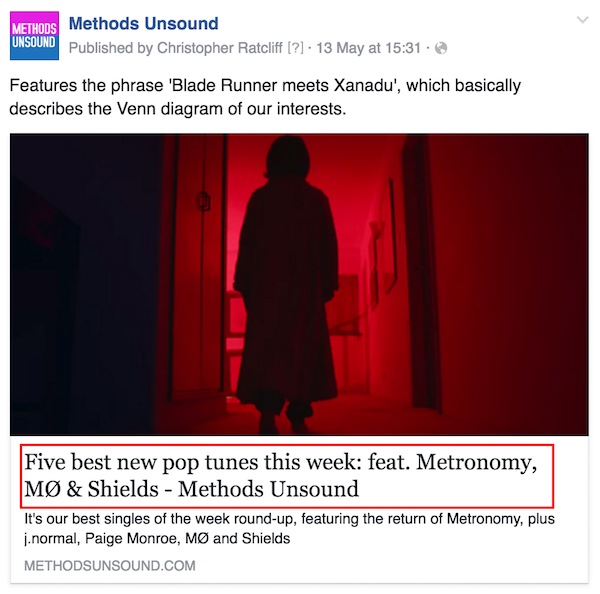
And most importantly of all, your title tag will show up as the big blue link in search engine results.
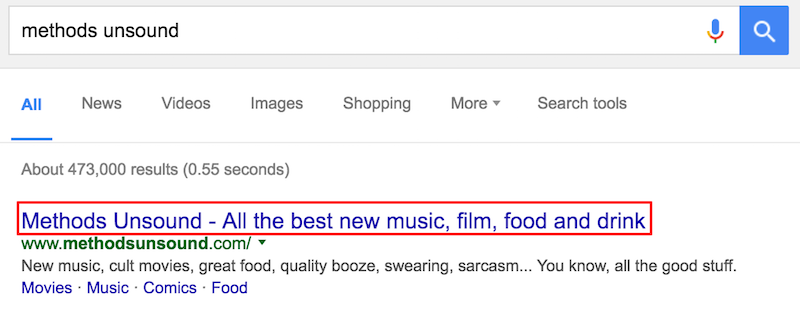
Where do I add the title tag?
You can add a title tag in the <head> section in your site’s HTML. It should look something like this:
<head>
<title>Example Title</title>
</head>
However in most content management systems (CMS), including WordPress, you can either add a title tag in general settings:
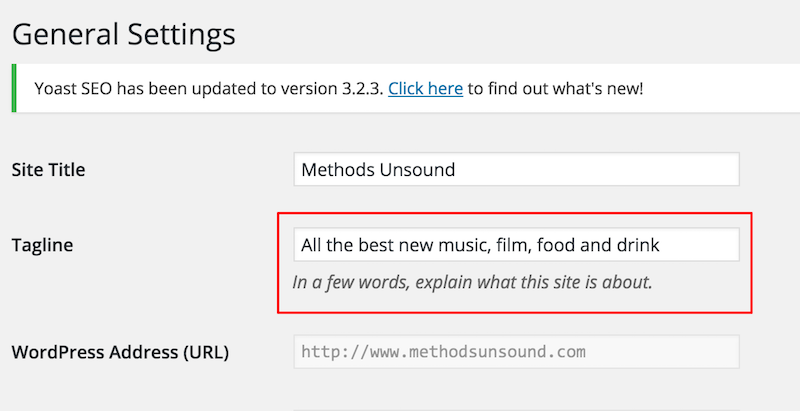
Or if you use an SEO plug-in, such as Yoast, you can add a title tag to the ‘SEO title’ section, and you can preview an example of how it will look in search engine results pages (SERPs):
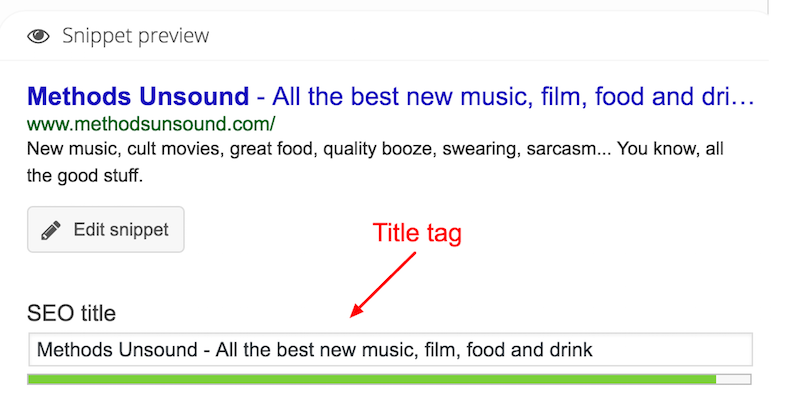
When writing an article, the section where you write a headline will automatically form the title tag.
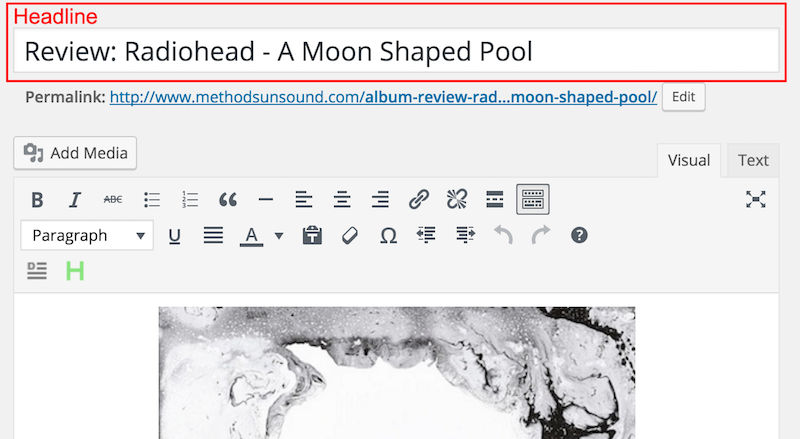
If your title tag is automatically generated from the headline, you should try to override this by using either a plug-in (like the one mentioned above) or in the HTML itself. The headline (also known as the <h1> tag) is another opportunity to tell Google about the content of your page using a slightly different keyword string, so you may as well take advantage of this.
Why are title tags important?
The title tag is the boldest, most obvious element in a search result and therefore a major part in the decision making process of whether a searcher will click on your result or not.
Are title tags used as a ranking signal?
According to Moz, title tags have “long been considered one of the most important on-page SEO elements.” And the closer to the start of the title tag any given keyword is, the more likely it will be to rank for that keyword based query.
How to write a great title tag
From an SEO point of view, the title tag should contain all the keywords you wish to rank for. And as I just stated above, the most important keyword should be at the beginning, followed by second most important, then finally your brand name.
Moz provides this handy reference:
Primary Keyword – Secondary Keyword | Brand Name
However one thing you must remember: write title tags for humans.
Although they’re formatted to some degree for search engines, it’s vital that the tag makes perfect sense to humans and reads like a legible sentence.
Title tag checklist
Kristine Schachinger wrote a perfect checklist on how to write optimised title tags in her original post, so I’m copying it for you here, with a few minor updates:
- Length: Title tags should be 50-60 characters long, including spaces.
- Keyword placement: Your most important keywords need to be first in your title tag, with your least important words coming last.
- Brand name: If your company name is not part of the important keyword phrases, put it at the end of the title tag.
- Do not duplicate title tags: They must be written differently for every page. Don’t mass replicate your title tags it will negatively affect your search visibility.
- Make it relevant: Title tags must accurately describe the content on the page.
- Do not ‘keyword stuff’ title tags: these are badly written title tags that try to rank for everything or repeat a word over and over. Keyword stuffing is the worst offense when it comes to title tags and you will be penalised for it.
- Avoid using stop words: These are words that have little keyword value. For instance articles such as ‘the’ ‘a’ ‘an’ and conjunctions such as ‘and’ ‘or’ ‘but’. However, you title tag should also make sense, so don’t avoid them entirely. It may be a better idea to just ensure your title doesn’t start with one of these stop words.
- Make your headline (<h1> tag) different from the title tag: This is another opportunity to vary the keyword phrasing of your page and increase its chances of appearing for different search intent.
Can Google override your title tag?
Occasionally yes. Sometimes if Google doesn’t like your title tag it will rewrite it for its search engine results, pulling in information from your meta description and page content. Chances are this won’t be as good as the one you’ve created, so you must ensure that your own title tag is completely relevant, descriptive, keyword rich but readable and the right length.
Good examples of title tags
Here are a few examples that stick to the above rules in our checklist and therefore look more appealing on the SERP.
‘best burgers in london’
Esquire has all three keywords right at the beginning of the title tag, then follows this with a seductively appealing headline (everyone loves a list) and cleverly uses ‘buns’ in order to avoid repetition and keep the character limit to around 60.

‘nike trainers’
Keywords are at the front, the brand name is at the end and Schuh has separated its keyword phrases with pipes | These used to be a necessity when writing title tags as the recommendation was to stay away from other punctuation. Although this is no longer true, pipes still look great on the page and are a clear separator.

‘radiohead moon shaped pool review’
Pitchfork has stayed away from a mistake that mine and other review websites make in putting ‘review’ at the start. Searchers do not start their search queries with ‘review’, they start with the artist.

Bad examples of title tags
And finally using the same search terms as above, here are some bad examples of title tags:
‘best burgers in london’
This is buried far down on page four of the Google SERPS. It’s easy to see why. The brand name and most important keywords are the opposite of where they should be. The headline itself also lacks any description or anything vaguely persuasive to make me want to click.

‘nike trainers’
The keyword is nowhere to be seen. In fact it’s probably at the end of the title tag, but because it’s so long it has been cut out by Google. Also note the wilful disregard of proper capping-up which makes the link look really spammy.

‘radiohead moon shaped pool review’
Although Mashable should be applauded for trying a different headline approach, the stop words at the beginning of the title tag push the important keywords into the middle and this result languishes on page 4 of Google. The headline’s great, but the title tag is identical, so perhaps all the tag needs is a slight reordering.

No comments:
Post a Comment